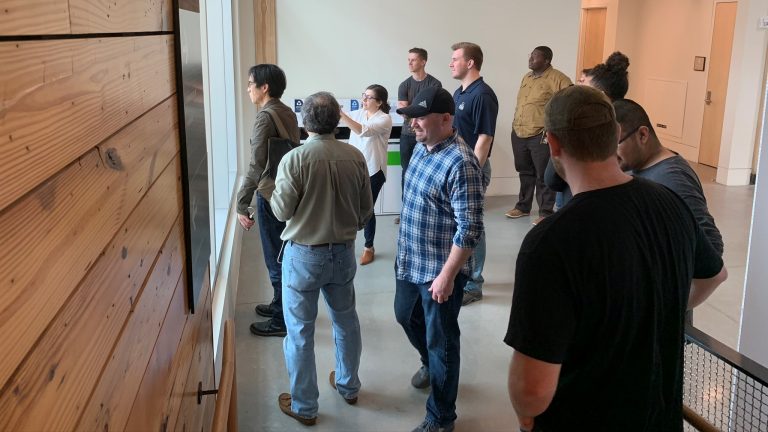Coronavirus has driven the Kendeda Building’s robust building tour program into the virtual world.
During construction, tours became a point of pride for the building’s project team. Once Skanska, the general contractor, handed the keys to Georgia Tech, the emphasis on showing off the many sustainable features carried over to Building Director Shan Arora.
“I have a mission to keep this building at the forefront of the conversation about what buildings mean for the environment, for sustainability,” Arora says. “Tours are an excellent way to do that.”
Living Building Challenge projects typically attract a lot of attention because they’re rare and cutting edge. That’s part of the mission, in fact. The LBC’s Education and Inspiration Imperative mandates that projects “share successful solutions and catalyze broader change.”
With a campus full of curious students and a high media profile, the Kendeda Building team leaned from the start into tours as a way to build awareness. While the building was under construction, Georgia Tech put a tour signup form on its site, and Skanska’s Jimmy Mitchell took on the role of chief tour guide.
Shortly before construction tours ended early last summer, Georgia Tech Program Manager Drew Cutright tallied the numbers: 2,128 people had taken part in more than 100 tours. According to Arora, another 2,500-plus people toured the building between August 2019 and the day it had to close in mid-March.
So what do you do when one of your main tools for outreach and education falls victim to social distancing and lockdowns?
It so happens that Arora had been working on an interactive image map for the building long before COVID-19 hit. He, colleague Kamilah Roberts and other support staff had been gathering “a treasure trove of content” that Georgia Tech and project team members had accumulated.
“The closure was abrupt,” Arora said, “But one of the first things I did was reposition the image map as a virtual visit, because that is really what it does — it gives you a tour of the building.”
On the current virtual visit, users can view the building from three of its four facades. From there, they can click on 30 “hot spot” icons to open popup windows that offer brief narratives, photographs and videos.
In early April, Arora and his colleagues launched Facebook, Instagram, LinkedIn and Twitter channels to reach a wider audience via social media. He and the team are now working on a second, “more immersive” virtual tour to dovetail with the existing image-map version. (DISCLAIMER: The Living Building Chronicle is separate from Georgia Tech. It’s an independent publication established by the Kendeda Fund to document the Kendeda Building project and to cover the broader regenerative building movement. Learn more about the relationship here.)
“We’re stepping back and asking, ’If people can no longer physically be there, how do we take the building to the people?’” Arora explains. “That was always our master plan anyway. I wanted to be able to promote the ethos of regenerative building to as many people as possible regardless of whether they can physically visit. Virtual tours and social media are a great way to extend this building’s impact.”
He acknowledged that visiting in person provides an “emotional experience” that can’t be replicated online. “When you see something new, like a composting foam-flush toilet, that in-person experience goes a long way to demystifying the technology.” But, he adds, “virtual visits and video tours are a fantastic way to establish a broader reach.”
Asked what advice he’d offer leaders on other sustainable projects seeking to amplify their message, Arora pointed to something fairly basic: “From the beginning, have robust social media and don’t be shy about promoting it — even paying to have good followers, because until [regenerative design] becomes as common as LEED, we need to get the word out as much as possible.”
PHOTO AT TOP: Lord Aeck Sargent’s Alissa Kingsley (center) leads University North Carolina Charlotte architecture students on a tour of the Kendeda Building in March. It was one of the last in-person tours before the building was shuttered because of the COVID-19 pandemic. Photo by Ken Edelstein.


